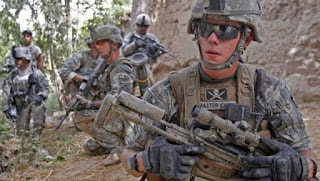 Here are two facts that should open your eyes. First, more than a decade of Iraq and Afghanistan warfare has increased the mental health diagnoses in the U.S. military by 65 percent. Second, a mental health provider willrecommend treatment of an unstable soldier, but the military commander can still send the soldier out on a mission – fully equipped with service rifle, grenades, and sidearm. This sounds like an extreme case, but it is actually an example of a common problem. Organizations use experts for many purposes, including those who control risks to human life, equipment, or finances, but the experts are often just advisors. The actual authority rests with the line manager in charge of operations. The difficult relation between the non-authority expert and the authority non-expert is important to understand because the whole point of experts is to take advantage of their expertise when needed. Now we know more, thanks to an article by Julia DiBenigno in Administrative Science Quarterly. She investigated the example I just gave: U.S. Army mental health providers and their relationship with line managers (commanders) who decide how soldiers are used or treated. This is a follow-up of an earlier article byDiBenigno showing that organizational procedures can be used to help create a more successful relationship. But even in organizations that are set up correctly, individual experts can still fail to reach the powerful line command. The main difference between success and failure was timing and speed. The mental health providers had a wide range of tactics to gain access to the commanders and subsequently gain their trust. What tactics they used depended on their resources. Because the army values military experience, anyone with military service or endorsement could use that to be recognized as an insider. Because the army values manhood, participating in rigorous training signaled commitment. Because the army values rank and protocol, learning and strictly following these helped communications. Doing each of these things quickly was essential because any specialist will sometimes make recommendations contrary to a commander’s wishes, and it is essential to build rapport before the first conflict happens. A worrying implication of this research is that so much depends on the personal characteristics and initiative of each expert. Two-thirds of the provider–commander connections were good enough that the commander often followed the provider’s recommendations. What about the soldiers under the command of the other one-third of the commanders? One-fifth of the providers were currently serving in the military, giving them a great advantage in gaining commander trust. What about the other four-fifths of the providers? Half the providers were female, in a context where gender is very meaningful. They would start out at the bottom rung of the trust hierarchy but could climb by, for example, participating in training. The men started out higher on the trust hierarchy but might fall quickly if they didn’t prove their manhood. All these findings suggest that the expert’s path to influence is a complicated one in organizations. My intuition is that it is probably worse in many other organizations than the army, for two reasons. First, the army is a pretty nonpolitical organization if we go far enough down the ranks – its culture of valuing “straight shooter” communication rather than intrigue reduces intra-organizational politics. Second, an army at war has an external enemy and an understanding that all insiders – even mental health care providers – are on the same team. The best advice to line managers from this research is to pay very careful attention to the experts, because many of them will not know how to gain trust and communicate their concerns. They need managerial attention and help, and you need their expertise. DiBenigno, J. 2019. Rapid Relationality: How Peripheral Experts Build a Foundation for Influence with Line Managers. Administrative Science Quarterly, forthcoming. Comments are closed.
|
Blog's objectiveThis blog is devoted to discussions of how events in the news illustrate organizational research and can be explained by organizational theory. It is only updated when I have time to spare. Archives
May 2024
Categories |
 RSS Feed
RSS Feed